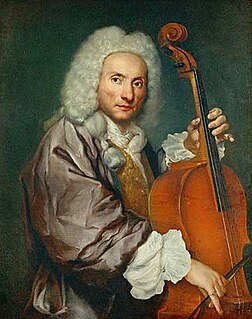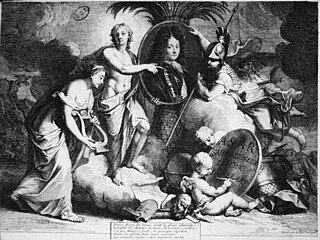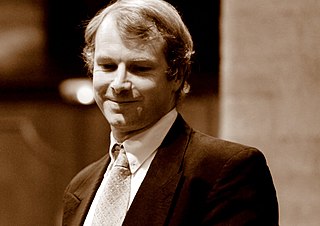Related Research Articles

The term sackbut refers to the early forms of the trombone commonly used during the Renaissance and Baroque eras. A sackbut has the characteristic telescopic slide of a trombone, used to vary the length of the tube to change pitch, but is distinct from later trombones by its smaller, more cylindrically-proportioned bore, and its less-flared bell. Unlike the earlier slide trumpet from which it evolved, the sackbut possesses a U-shaped slide with two parallel sliding tubes, rather than just one.

Giovanni Battista Draghi, often referred to as Giovanni Battista Pergolesi, was an Italian Baroque composer, violinist, and organist. His best-known works include his Stabat Mater and the opera La serva padrona. His compositions include operas and sacred music. He died of tuberculosis at the age of 26.
The trio sonata is a genre, typically consisting of several movements, with two melody instruments and continuo. Originating in the early 17th century, the trio sonata was a favorite chamber ensemble combination in the Baroque era.
The year 1724 in music involved some significant musical events.
The year 1676 in music involved some significant events.

Giovanni Legrenzi was an Italian composer of opera, vocal and instrumental music, and organist, of the Baroque era. He was one of the most prominent composers in Venice in the late 17th century, and extremely influential in the development of late Baroque idioms across northern Italy.
The year 1699 in music involved some significant events.

Giovanni Battista Cirri was an Italian cellist and composer in the 18th century.
Giovanni Girolamo Kapsperger was an Austrian-Italian virtuoso performer and composer of the early Baroque period. A prolific and highly original composer, Kapsberger is chiefly remembered today for his lute and theorbo (chitarrone) music, which was seminal in the development of these as solo instruments.
Giuseppe Valentini, nicknamed Straccioncino, was an Italian violinist, painter, poet, and composer, though he is known chiefly as a composer of inventive instrumental music.
Giovanni Battista Granata was an Italian Baroque guitar player and composer. He is generally known as the most prolific guitarist of the 17th century, publishing seven books during his lifetime. Along with many pieces in the standard dance genre of that time, Granata also composed many instrumental toccatas, preludes, and chaconnes. Granata was a barber-surgeon by profession.
The year 1622 in music involved some significant events.
The year 1617 in music involved some significant events.

Jean-Baptiste Stuck was an Italian-French composer and cellist of the Baroque era.
Giovanni Felice Sances was an Italian singer and a Baroque composer. He was renowned in Europe during his time.

Max van Egmond is a Dutch bass and baritone singer. He has focused on oratorio and Lied and is known for singing works of Johann Sebastian Bach. He was one of the pioneers of historically informed performance of Baroque and Renaissance music.

The Ricercar Consort is a Belgian instrumental ensemble founded in 1980 together with the Ricercar record label of Jérôme Lejeune.
Das neugeborne Kindelein, BWV 122, is a church cantata by Johann Sebastian Bach. Bach composed the chorale cantata in six movements in Leipzig for the Sunday after Christmas and first performed it on 31 December 1724.

Francis Jacob is a French organist and harpsichordist.
Pietro degli Antonii was an Italian composer.
References
- ↑ Michael Talbot Aspects of the Secular Cantata in Late Baroque Italy 2009 Page 94
- ↑ Andreas Giger, Thomas J. Mathiesen Music in the mirror: reflections on the history of music theory 2002 p146
- ↑ Giovanni Battista Brevi. Deliciae terrenae: Sopran (Tenor) und Basso continuo 1958 16 pages
- ↑ Giovanni Battista Brevi O spiritus angelici: Alt und Basso continuo 1961 - 13 pages
- ↑ Giovanni Battista Brevi Catenae terrenae: per la Beata Vergine Maria : Bass und Basso continuo 1957 - 16 pages